Husband’s Overall Review After Owning the Mercedes-Benz SL500 (R129) for Six Months
公開日:2018.11.11
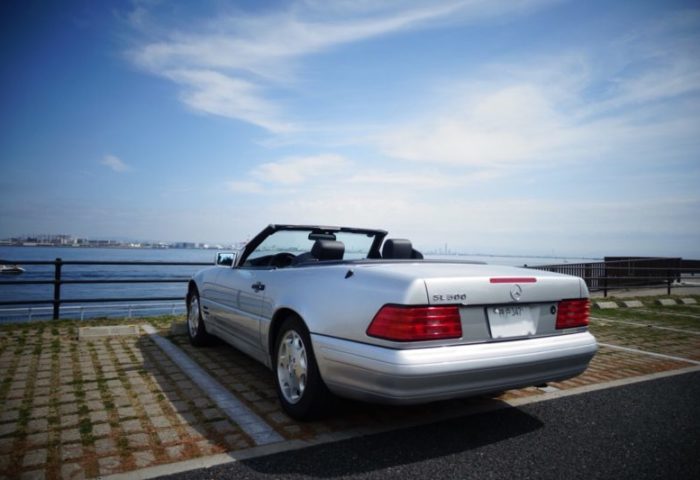
The 964 Carrera 2 Has Arrived
Last Friday, our long-awaited air-cooled Porsche (964 Carrera 2) finally arrived at our home. I plan to share a detailed review of its specifications and driving impressions here on the blog soon. Actually, with the arrival of this air-cooled Porsche, we decided to part ways with the Mercedes-Benz SL500 (R129) that had been with us until now.
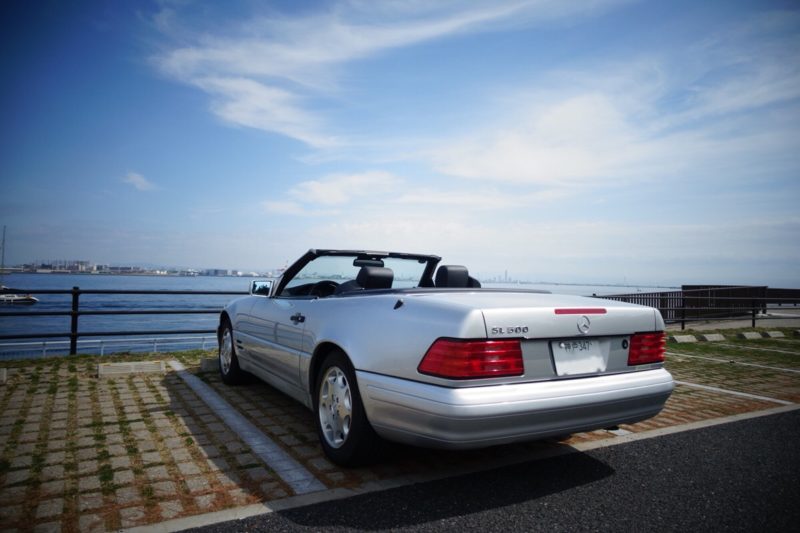
So, this time I’d like to share my husband’s impressions after owning the legendary SL500 (hereafter R129) for about nine months.
Mercedes-Benz SL500 (R129) Overall Review
After purchase, the mileage was about 4,000 km. From long tours to daily driving, commuting, and winding roads, my husband drove the R129 in a variety of situations. (I only drove it about three times.) Here are the parts of the SL500 that left the strongest impression on him, along with his overall thoughts.
① Suspension: Soft Yet Tenacious
When he first got behind the wheel, my husband was struck by “how incredibly soft the ride was.” Since he often drives Porsches, this contrast was even more noticeable, but even setting that aside, he said “I think it’s on the softer side.” Specifically,
It felt like walking on a thick carpet laid out in a luxury hotel lobby or hallway.
He described it as if a carpet had been laid over the road. However, it’s definitely not the kind of soft, fluffy ride you get from a Japanese luxury sedan. Despite the softness, the damping was firm, resulting in a flat, composed ride.
My husband took the R129 on long tours and winding roads, but before tackling those twisty routes, he honestly wondered “Is it really okay to have such a soft suspension?” So how did it actually perform?
“At first, I was worried, but once I threw it into a corner, it allowed a fair amount of body roll while instantly delivering a strong sense of grip and contact with the road. It grabs the surface firmly, applies appropriate load to the outer tires, and handles everything without breaking loose. Also, while the steering feels loose and somewhat vague during normal driving, when I had to make a sudden sharp turn to avoid an obstacle on the road, it responded quickly and precisely, then smoothly returned to the original line as if nothing had happened. I always think this is where Mercedes really shines.”
What my husband always admires about Mercedes-Benz is
“Soft and supple, yet when it counts, it turns properly, drives properly, and stops properly.”
People often say European cars like Mercedes-Benz are safe, but he emphasized that this safety isn’t just from the body’s rigidity and crashworthiness, but from “the high level of driving performance that provides active safety, increasing the chances of avoiding danger and thus making the car safer.”
② Solid Feel and Doors
The R129 is said to be “the last generation to carry the traditional Mercedes character,” so I asked my husband if he agreed.
I think so. The doors have a solid weight and feel completely different from modern S-Class coupes or SLs. The door closing sound is a metallic ‘clunk!’ with a heavy, substantial tone. The trunk, controls, and all switches have a solid, clear ON/OFF feel, and you can even sense the maker’s intention of “this is how it should be.” I think that solid feel while driving translates into a sense of security and stability. The highway stability is a given, and at speeds leading the passing lane, nothing feels out of place. It’s hard to believe this is a 20-30 year old car in terms of stability. It’s truly an ideal grand tourer for long distances.”
He praised it highly.
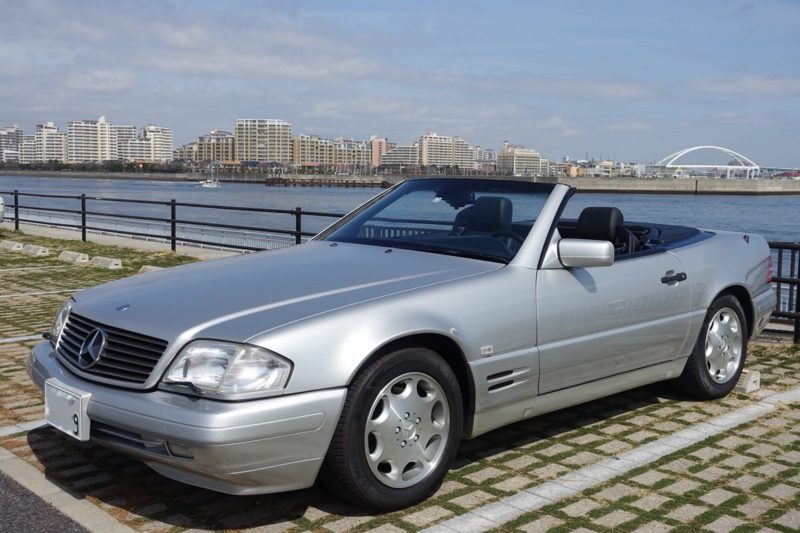
③ The Roar of the M119 V8 Engine
Our R129 is a mid-term model equipped with the M119 engine before it switched to SOHC (Single OverHead Camshaft). This engine debuted in the 1980s, known for its high safety and driving performance, and was used in the acclaimed “W124” E500/500E, often praised for its over-engineering. It features a “V8 DOHC 4,973cc” engine.
My husband said this about the M119 engine:
I really think it’s a masterpiece. With 320ps (235kW) at 5600rpm and 48.0kg·m (470.7N·m) at 3900rpm, it’s “modest specs for a 5L V8” by today’s standards, but its character is excellent.
The twin-turbocharged version of this engine was used in the 1989 Le Mans 24-hour winning Sauber C9 and the 1991 Mercedes-Benz C11.
…The Sauber!? …C11? (*_*)(They just dropped some unexpected trivia here!)
A bit of research revealed that the C11 was a Group C racing car built in 1987 by the Swiss Sauber team led by Peter Sauber to compete in the WSPC, and it recorded a top speed of 400 km/h during the 1989 Le Mans 24-hour race.
…400 km/h… (;゚Д゚)
“But this engine doesn’t show off its pedigree in everyday driving; it just quietly does its job. But when you press the accelerator deeply, torque comes on instantly. You can’t get this kind of throttle response from modern turbo V8s. In fact, when compared to the current Panamera Turbo, the torque response when pushing hard in 2nd or 3rd gear is clearly quicker in the naturally aspirated SL500 (R129).
That’s the power of NA engines. Although modern turbos have greatly reduced turbo lag, they still can’t quite match the immediacy of a naturally aspirated engine.
Regarding the engine sound, when driving on winding roads and revving from mid to high RPMs, it finally lets out that true V8 roar. The overall volume is quiet, but the beat and intricate mechanical noises feel incredibly satisfying, reminding us that engine sound quality isn’t just about loudness. This car really taught me that.”
The more I hear, the more I realize what a classic this car is.

④ Enjoying Three Styles: Hardtop, Open, and Soft Top
The R129 comes standard with a hardtop. This hardtop is quite large and very heavy, weighing about 34 kg, so it’s difficult to remove or install alone. At our house, my husband and I always had to lift it together from both sides to manage it. (There are YouTube videos showing how to do it alone, but I definitely wouldn’t recommend it—you’ll almost certainly scratch the body.)
With Hardtop Attached
With the hardtop on, you can enjoy a complete coupe style. It improves quietness and, above all, stiffens the body. While the SL already has a very rigid body, compared to modern open two-seaters like the Boxster, you can still feel some body flex.
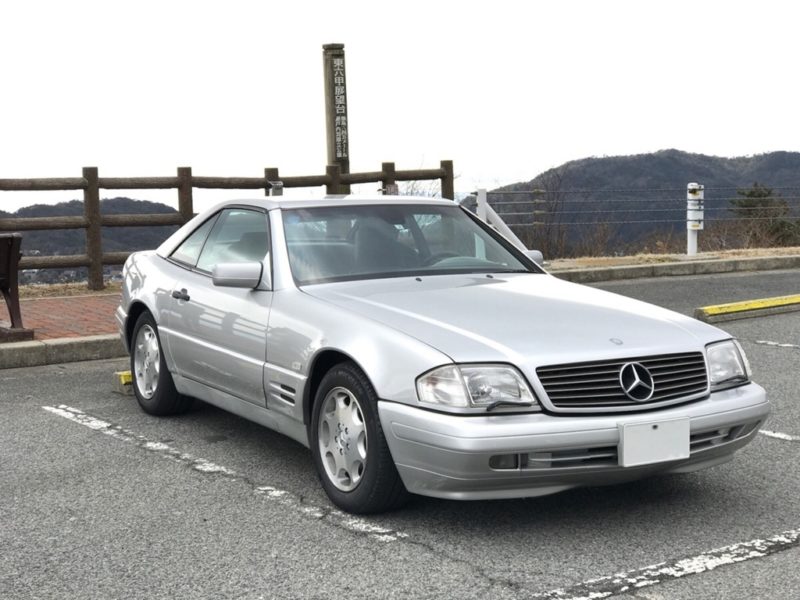
My husband says that “the driving feel seems to step up a notch” with the hardtop installed. Personally, he likes the R129 best with the hardtop on.
Open Top
On the other hand, removing the hardtop transforms the car into an open, liberating ride. It already has relatively little wind buffeting, (I’ve driven it open myself and didn’t find it bothersome at all) and adding the optional wind deflector reduces buffeting even more, dramatically improving comfort.
Compared to the 981 Boxster, which tends to have more wind buffeting,
my husband says the R129 has about one-third to one-quarter as much wind buffeting.
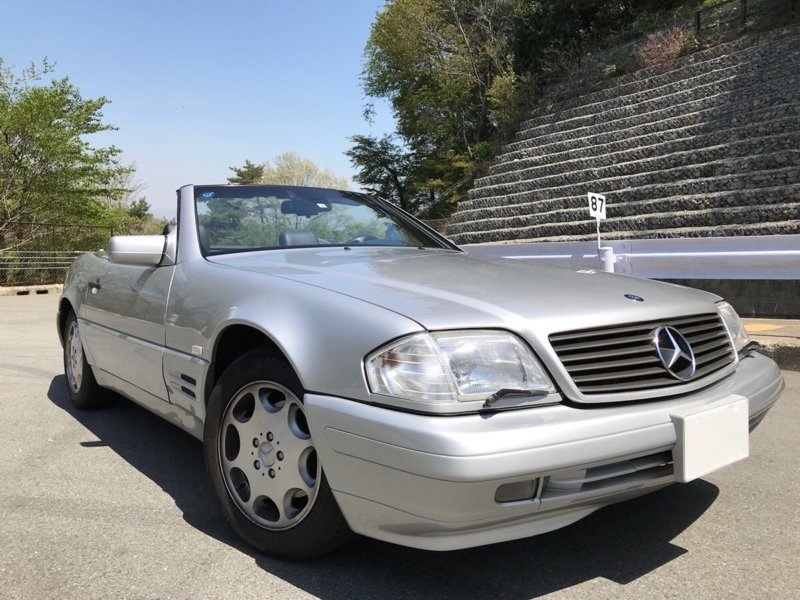
I asked, “But doesn’t driving open make the body flex feel even more noticeable?”
“Actually, when driving open, the body flex becomes less noticeable, and it even feels like the car’s acting as a cushion, smoothing out road shocks. It’s smooth and pleasant even without high speeds, perfect for a calm cruising driving style.”
With Soft Top Attached
The soft top is also very well made, with no cheap (Kansai dialect for ‘low quality’) feel at all. It has a sturdy metal frame with thick fabric, and even at highway speeds, there was almost no flapping.
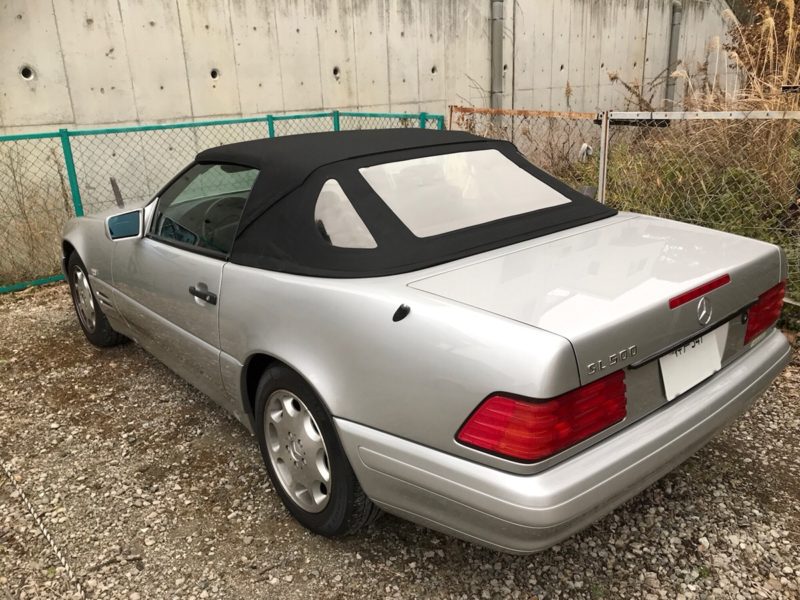
The 12 hydraulic cylinders, praised by Car Graphic magazine at the time as “technology more advanced than the moon landing,” open and close the soft top fully automatically in about 30 seconds. While it doesn’t offer the same quietness or weather resistance as the hardtop, it never felt uncomfortable, even on long tours.
⑤ All or Nothing
If I had to sum up the R129 in one phrase, it’s a model that strongly embodies Mercedes’ philosophy of “The best or nothing,”
my husband says.
Every device, feature, and mechanism is a cost-intensive masterpiece, with many advanced systems that you wouldn’t see nowadays. From the complex fully automatic hydraulic soft top system to the air-controlled door locks, heavy doors, precisely balanced OEM wheels, and subframes welded directly to the main frame… the list goes on. It’s clear that cost was secondary to achieving the best possible quality.
Final Thoughts?
So, here is my husband’s overall conclusion:
Owning the R129 this time really helped me understand what it means to have a car with high costs invested in it, and it broadened my own values and perspective toward cars. The R129 is now quite rare, and with rising prices overseas, many are being exported abroad, but I highly recommend any Mercedes enthusiast to own one at least once—it’s a true classic.
I see. It’s a shame such a classic is flowing overseas so rapidly. I hope the R129 finds a new owner who will cherish it as much as we did.
このブログが気に入ったらフォローしてね!


Comment ( 0 )
Trackbacks are closed.
No comments yet.